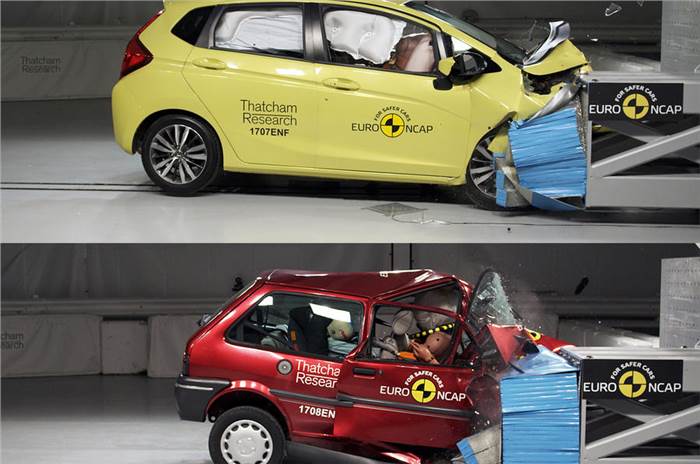Euro NCAP has released a dramatic video that graphically demonstrates the massive improvements made to car safety over the past 20 years. The footage shows a 1997 Rover 100 that crumples up in a 64kph offset frontal impact, seriously injuring the driver, alongside the latest Honda Jazz, which provides a high level of protection to its occupants.
“Wherever you were sitting in the Rover 100 it was bad news,” said Matthew Avery of Thatcham Research, one of Euro NCAP's crash test centres. "In a head-on crash at 64kph, you definitely do not walk away.” The occupants of the Honda Jazz are likely to have walked away from the same crash with just bruising.
Euro NCAP is using the video to celebrate the fact that its crash testing has helped to halve the number of people killed on the UK's roads since 1997, with the figure down from 3,599 in 1997 to 1,732 in 2015. The number of pedestrians and cyclists killed and injured on our roads has also dropped by 40 percent since 1997.
Across Europe, more than 78,000 lives have been saved since Euro NCAP’s tough crash safety tests were launched 20 years ago this week. Today, Euro NCAP revealed it has published over 630 safety ratings, crash-tested some 1,800 cars and collectively spent over 160 million euro to make cars safer. The first tests exposed safety failings in top-selling family cars, forcing a fundamental rethink in the way vehicles were designed to prevent accidents and save lives.
Twenty years on, nine out of 10 cars sold on the European market hold a Euro NCAP rating and the motor industry actively supports the development of new requirements for the top safety ratings. Today, the results of crash tests (4) of two family cars built 20 years apart underline the huge advances in vehicle safety since 1997. Safety technologies that were non-existent or optional at most – such as driver and passenger airbags, side protection airbags, belt reminders and electronic stability control – are now standard on all cars sold in Europe.
“As we mark 20 years at the forefront of road safety, we are very proud that Euro NCAP’s programme of safety tests has achieved major, life-saving improvements in cars and has helped Europe reach the lowest road fatality rate for any region in the world,” said Euro NCAP’s secretary general, Michiel van Ratingen.
His sentiments were echoed by Max Mosley, the first chairman of Euro NCAP and chairman of Global NCAP, who said, “Twenty years on from what started as a controversial programme, rejected by manufacturers and supposedly aiming for unrealistic safety standards, Euro NCAP is now firmly part of the automotive mainstream. Thousands of fatalities have been prevented, consumer demand for safety is high, manufacturers compete on safety rating results and vehicle safety standards continue to improve.”
However, Euro NCAP wants to cut the number of deaths and injuries on our roads further by getting car companies to make autonomous emergency braking (AEB) standard equipment on all new cars. It states that doing so would prevent 2,700 deaths and serious injuries in the UK every year. It is also calling on motorists to buy only Euro NCAP five-star-rated models and to ensure their cars are fitted with autonomous emergency braking and a lane keeping assistance system. Euro NCAP isn’t standing still. It is introducing new tests in 2018 to assess lane assist systems that can control a car’s steering to avoid a potential collision, systems that will help to reduce crashes at road junctions and improved pedestrian and cyclist-detecting AEB systems.




Comments
Member Login
Personal Details
No comments yet. Be the first to comment.